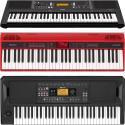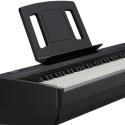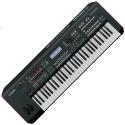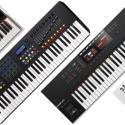Digital Piano vs Keyboard. The Differences & the Hybrid Options
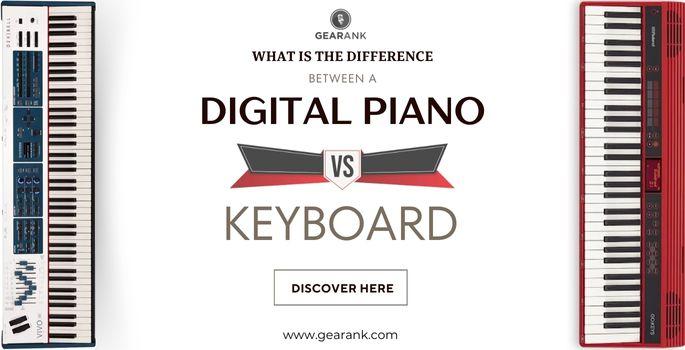
The acoustic piano is impractical for most beginners due to its large size and high cost. Thankfully, there are plenty of good alternatives in the form of digital pianos vs keyboard pianos.
While these two popular electronic instruments share similar keys and sounds, there are important differences. Knowing their quirks can help you identify which one fits your musical preferences.
Definition of Terms
Before we get to the details, let's define the terms we will use.
The term keyboard technically encompasses a variety of instruments that have piano keys. But more often, this term is used to refer to portable keyboards. So, when we say keyboard in this article, we refer specifically to portable keyboards.
On the other hand, the term digital piano is already specific, so there's no further clarification needed.
The Similarities of Digital Pianos and Portable Keyboards
To better appreciate the differences, let's first look at their similarities.
Most digital pianos and keyboards share the same rectangular profile and have the same ebony and ivory keys. They both look similar, much like a miniature piano.
Both also come with built-in piano sounds and speakers. They are also electronic instruments that are powered by electricity.
So, to the untrained eye, they can look very alike.
But closer inspection will show their many differences. The most obvious is the Portable keyboards' barrage of buttons vs. the streamlined furniture-like design of digital pianos.

Console digital pianos are separated further with their distinct wooden stands, making them look more like acoustic pianos. Meanwhile, certain portable keyboards boast larger buttons known as trigger pads and mod wheels that set them apart even more.
The Differences Between a Digital Piano and a Keyboard
The variances between digital pianos and portable keyboards are due to their specific purposes. While some overlap, their purpose and target market are decidedly different.
Digital pianos aim to replicate the acoustic piano sound and feel. This means that much of the cost and design of the instrument is focused on getting the feel of the keys right. This produces a realistic and responsive sound. This results in fewer extras, which can distract from their primary purpose.
On the other hand, portable keyboards are designed to be mobile & comprehensive musical instruments. Unlike digital pianos, they provide a wider range of features. This includes hundreds of voicings, sounds, effects, and more. Some portable arranger keyboards can even be used for one-man-band accompaniment.
Another point of difference is their target audience.
Many digital pianos are designed for those who aspire to become trained pianists. They are meant to be played much in the same way as an acoustic piano, ideal for traditional or classical piano pieces.
On the other hand, keyboards are more popular among musicians looking to showcase their creativity. It is also meant to provide musicians with as many sonic options as they need for performances or recordings.
What Is A Digital Piano (How Is It Different To Acoustic Pianos?)
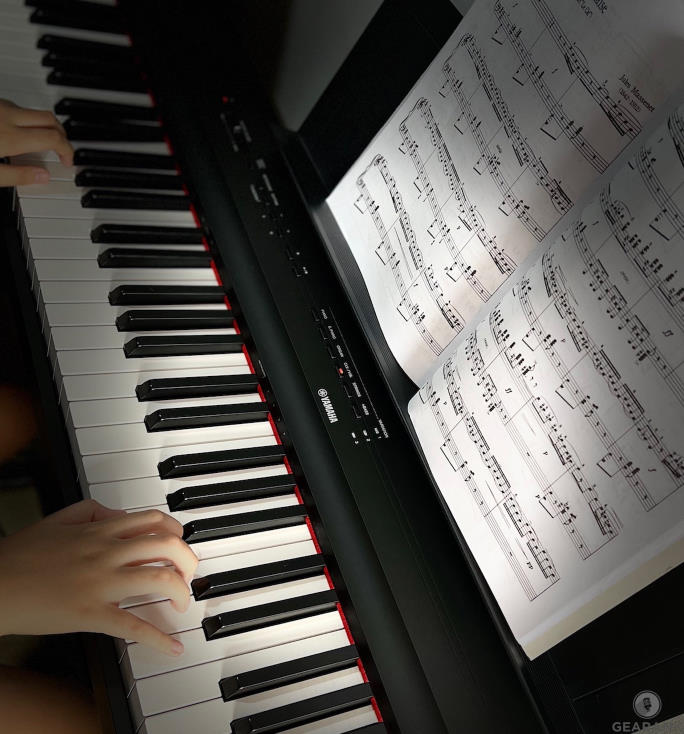
A digital piano sounds much like an acoustic piano. They provide a more authentic piano sound and feel than keyboards and can get new pianists used to real acoustic pianos without purchasing one.
Digital pianos are popular for their accessibility and portability, which traditional pianos can't provide.
They can replicate the sound of an acoustic piano through built-in speakers and replicate the appearance and look of a real piano in a smaller, more compact, and easy-to-move design. You no longer have to worry about the weight of heavy pianos!
Digital pianos also do not need tuning, which is a big deal for beginners who still need to improve at telling if the pitch is off. This also means less maintenance cost.
Another student-friendly feature is the ability to use headphones for quiet practice and for listening to your recordings. With this, you can practice without annoying the neighbors or family members. Some digital pianos even come with dual headphone outputs, allowing students and teachers to go through with their lessons quietly.
Another important feature of digital pianos is their weighted keys. These are meant to replicate acoustic piano keys' hammer action and bounce. Some even feature graded weights where the lower notes are heavier.
Traditional pianos are not portable instruments and often require professionals to move them. So, an electric piano is often the instrument of choice for many pianists.
They are more cost-effective, do not require upkeep, and are like traditional pianos.
What Is A Keyboard?
The keyboard piano is intended for use as a portable kind of piano. The focus is not much on the feel but on usability.
These are typically lightweight and usually have 61 keys rather than a full 88 keys, making them smaller and more manageable.
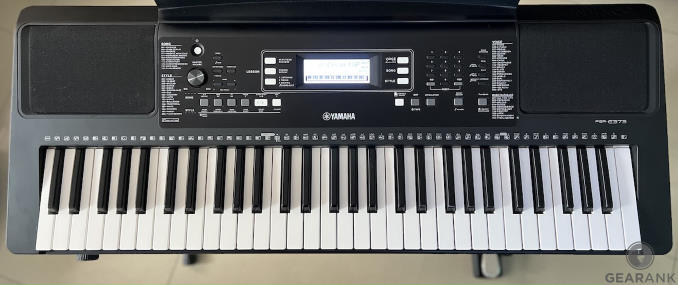
The keys are generally semi-weighted or unweighted, making playing easier for children. But the keys have no comparable qualities to acoustic pianos. A keyboard also has more noise than a digital piano and does not have the same feel as an acoustic piano.
Most electronic keyboards are used for their synthesized sounds to make music or perform rather than replicating the sound of stage grand or acoustic pianos.
An electronic keyboard may also have auto-accompaniment features, software synths, a MIDI controller, and multiple key configurations to create sounds from many instruments rather than one particular instrument.
You can become a one-person band with a keyboard and create various sounds and beats!
Digital Pianos vs Keyboards
In this section, we will pit keyboards and digital pianos against each other to see the key differences and identify which qualities you like best.

Key Action & Sensitivity
The term key action describes the way the keys respond to your playing. Digital pianos win this section because they usually have semi or fully-weighted keys. Weighted or Hammer action keys feel and respond like an acoustic piano. Some even have graded keys, where the lower notes are heavier, and the key weight decreases as you get to the high notes on the right.
The weight also influences the way the keys bounce back from being pressed. This enables a real piano experience and informs the technique for practicing piano correctly.
It should be noted that traditional piano purists aren't 100% happy with how weighted keys respond. And there is no replacing the authentic feel of a real acoustic piano. But the weighted keys of electronic stage pianos are inching closer to the real thing.
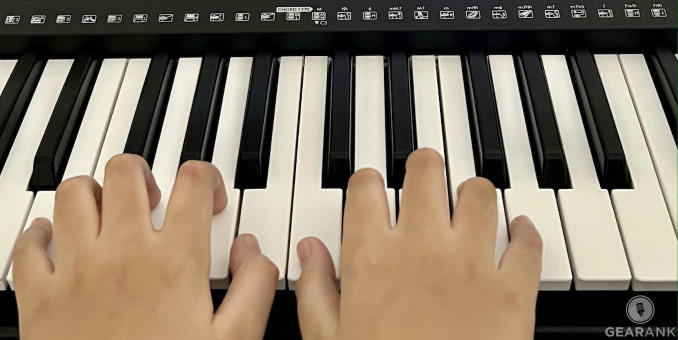
Keyboards typically have synth-style or non-weighted keys, which are easier to press but won't feel like a real piano. But there are some high-end keyboards with semi-weighted keys. Some even have fully-weighted keys similar to the keybeds found in the digital piano category. MIDI controllers are also getting better at capturing the playing feel of a stage piano.
Semi-weighted offers an in-between feel, not too soft but not as heavy as an acoustic piano. Many keyboardists prefer this because of its good balance of feel and portability.
Aside from Key Action, another essential consideration is sensitivity. This is the instrument's ability to sense and respond to how fast and hard you press the keys. The note's sound will be louder or quieter depending on how forceful you are on the keys.
Good digital pianos and keyboards are expected to have this feature but at different quality levels. As expected, more expensive options have better features like improved velocity sensitivity, resulting in realistic piano sound and response.

Some premium keyboards come with a degree of weight adjustment and sometimes even aftertouch settings. This allows for more expressive control over the sound of instruments, like adding vibrato to a sax sound as you hold the key.
Note that good key action and sensitivity generally require complex components to work. This is why digital pianos tend to be heavier overall, weight and higher cost too. So don't expect much of this in compact portable keyboards.
This really is the main drawback of a portable instrument, lightweight keyboards generally don't have great playing weighted keys. But they will come with different sounds, backing track options, and a lot of extra features.
Sound Quality and Quantity
When it comes to essential piano and organ sounds, digital pianos are generally better.
This is one of the upsides of its fewer features. More of the instrument's DSP (digital signal processing) power is focused on just a few essential sounds. It results in high-quality sound samples.

Whereas digital keyboards can have hundreds of sounds, but the piano voicings can be lacking.
There's also the issue of unwanted noise, like keys clicking when you play a keyboard, which can be off-putting.
Digital pianos and electric pianos can mimic various acoustic piano tones, as you can play with various degrees of pressure or with the sustain pedal depressed to alter the overall feel of the piece - just like the real thing.
Almost all digital pianos are designed with acoustic music modeling. But, if you want more options with an extensive sound collection and individualizations, a digital keyboard piano would be a better alternative. Keyboards give you more sound options, effects, and parameter control.
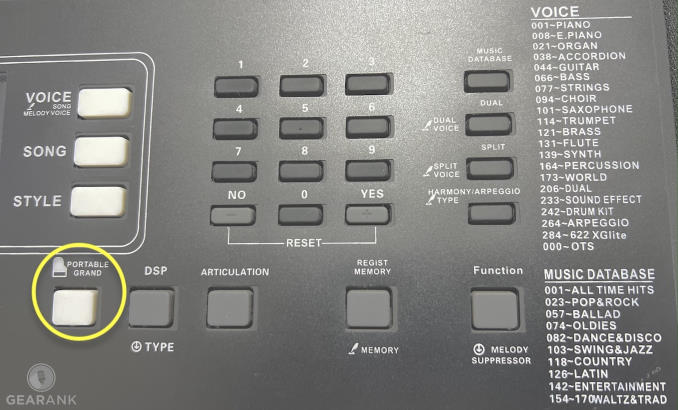
Note that newer portable keyboards get good-sounding piano voices, thanks to advanced DSP technology trickling down on affordable models. A good example is the Yamaha PSR-E373 with piano sound samples from a costly Yamaha CFX concert grand piano.
Number of Keys and Portability
A portable keyboard generally has fewer keys than the full 88 keys on a digital piano. The majority of portable keyboards will have 61 or less keys.
The advantage of having a complete set of 88 keys is playing traditional music without switching octaves. But more keys require more space.
I used to think that 88-key digital pianos were portable until I had to take one on the road in a car. It was not a comfortable situation. I prefer to play an 88-key digital piano if available at the venue. But I'd opt for a portable keyboard if I had to bring my instrument.
Digital pianos have more keys but are challenging to carry around. Portable keyboards are better for those on the go.
Which is the Best Choice for a Beginner?
A digital piano will provide a more realistic playing experience for piano students. It has a full set of 88 keys with hammer action for a realistic feel. And some even come with a wooden stand to replicate the look of a real piano.
But even though they are smaller than acoustic pianos, digital pianos are still quite big and may not be practical for some students. There's also the cost factor - digital pianos are more expensive.
Electronic keyboards have limited playability but are lighter and take up less space. They are ideal for students who want to continue playing even in small rooms and while having to travel around.
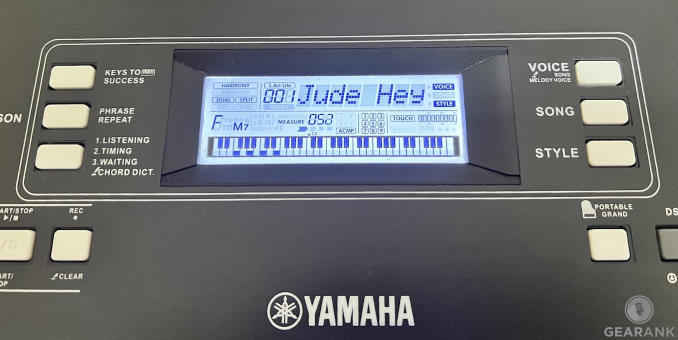
It's also important to note that keyboard pianos generally have better built-in tutorial features, which can help students learn faster and more efficiently. This is an important feature, especially for those who plan to go the self-taught route.
Should You Learn To Play On A Digital Piano Or A Keyboard?
This ultimately depends on what style of music you want to play. If you want to learn how to play the piano properly and to a high standard, starting with a digital piano is best. This can get budding pianists used to the feel of a piano, using pedals, and the weight of the keys. You don't always get that advantage with a keyboard.
On the flip side, learning to play modern music, jamming with friends, and producing tracks is easier with a portable and versatile instrument like a portable keyboard.
Hybrid Options
The lines that divide the two can sometimes be blurred. So you'll sometimes see the keyboard and digital piano cross over into each other's territory. Some hybrid options even completely reverse their expected roles, like digital pianos with synth keys and portable keyboards with semi or fully weighted keys.
Portable digital pianos is one example, they offer the same full size keys, but with a more compact and lightweight profile. And it is able to shed some of its bulk and weight by sacrificing some of its playability and settling for a basic synth style keybed. They are a good inbetween for those who want the many notes and simplicity of a digital piano, but in a lighter form factor.
On the other hand, some high-end keyboards combine the weighted keybed of a digital piano, with the expansive feature set of a digital keyboard. You'll often see this amalgamation of features in professional arranger and workstation keyboards. These are expensive yet versatile instruments, able to blur the lines between synthesizer vs keyboard vs digital piano.
Some features spill over into the two types. This includes basic effects, recording, built-in piano lessons, MIDI compatibility, and more.
The bottomline is to choose which ones suit your mobility and playability requirements.
Key Takeaways
To summarize, both digital pianos and keyboards are great instruments for those wanting to learn how to play. But they have important distinctions.
A digital piano will give you a more realistic piano experience. For serious students and experienced pianists, a digital piano is often the best choice.
But if you're looking to be creative and want a keyboard instrument that's easier to carry around, then get a portable keyboard.
Now, you can identify the differences and nuances of the digital piano vs keyboard piano discussion. And you can now make an informed choice as to which one to get.
Video Demo of the Yamaha P-125 Digital Piano:
Video Demo of the Yamaha PSR-E373 Portable Keyboard:



